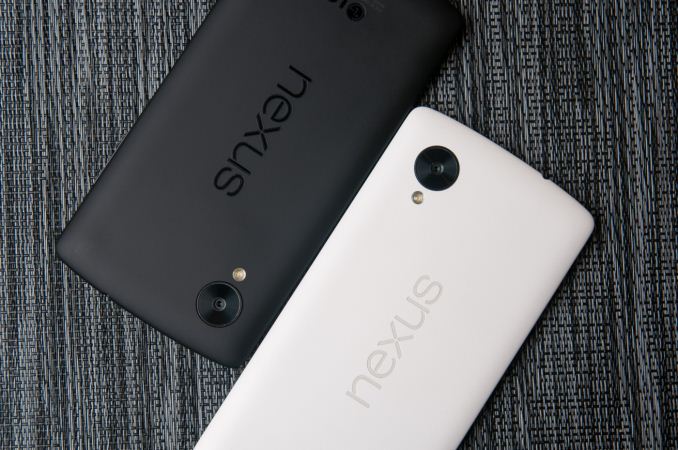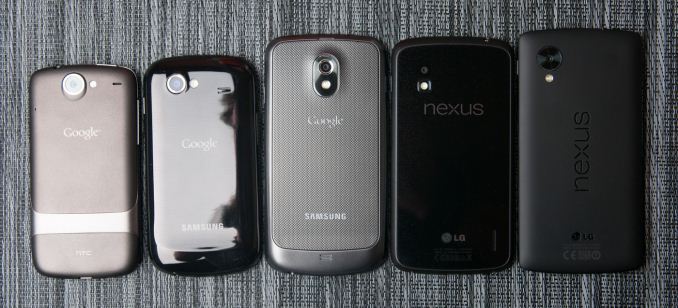Google Nexus 5 Review
by Brian Klug on December 5, 2013 8:00 AM EST- Posted in
- Smartphones
- LG
- Android
- Mobile
- Snapdragon 800
- Android 4.4
- Nexus 5
As is often the case, the conclusion to this Nexus review is one part software, and one part hardware. I'll start with a discussion of Android 4.4.
Google adds a subtle but appreciated level of polish to the Android UI with its latest iteration of the OS. This has been true for a while now, but the Android we're talking about today is really a far departure from what existed back in the early 2.x days. Anyone who hesitated to move from iOS back then will find themselves with an OS today that is clearly a substitute good. What once was an OS that only appealed to a crowd that appreciated its flexibility is now just as approachable as anything else on the market, and just as powerful as it always has been.
Likewise, Android is now smoother than before thanks to further improvements brought forth by project butter and refinements to the GPU-accelerated 2D rendering pipeline that was introduced in Android 3.x Honeycomb. Like any platform, it's still possible to craft apps that jank, but you have to look hard for examples that truly drag the experience down, and on the whole almost all the system apps are polished and performant. Project svelte also reduces memory footprint for midrange (emerging market) devices with 512 MB of RAM, where most of the remaining growth is for the smartphone market abroad and at home. I can't wait to see how that bears itself out even on devices like the Moto G with 1 GB of RAM or less, since it's hard to immediately find the difference on flagships with 2 GB or more that aren't always under high memory pressure.
I'm glad to see the antiquated SMS/Messaging app gone, but I'm puzzled by the poor integration into Google's new Hangouts app. The Hangouts experience in Android remains incredible, but the SMS component is far from the sort of seamless integration I had hoped for.
The most disappointing part about Android 4.4 is the miserable camera UI, but I'll get to its impact on the Nexus 5 in a moment.
For the price, the Nexus 5 is easily one of the best buys on the market today. At $349 you not only get the absolute latest hardware, but the most accurate 1080p display available on an Android device. I really can't give Google enough credit here for doing what literally no other Android OEM seems to care enough about and actually shipping a display with proper sRGB coverage. It's not quite as good as what you'll get from a 2013 Nexus 7, but it's easily the best I've ever encountered in all of my experience with Android devices.
It's good to see the default storage capacity move from 8GB to 16GB, but I would really like to see Google embrace even larger options. There's no reason Google couldn't offer a 64GB Nexus 5, and/or be a little aggressive on NAND sourcing and push for a 128GB model as well.
The fact that the Nexus 5 ships unlocked at its price point is another huge selling point. It seems to me that what you can get for $179, $349 and $599 is improving substantially across the market. I would love to see Google extend the Nexus family both up and down the pricing spectrum to really provide excellent solutions for all segments of the market.
The camera story on the Nexus 5 is among the most frustrating aspects of this phone. From a hardware perspective, Google has settled on a combination of sensor and optics that's quite close to the most optimal configuration available today, and a dramatic improvement from the Nexus 4. The problem with the Nexus 5's camera is entirely limited to the horrible mess that is the default Android camera app. We're nearly into 2014 yet substantial shutter lag, focusing issues and a preview that doesn't reflect reality are still problems with the AOSP camera. The fact that many other Android OEMs have already worked around some if not all of these issues is hugely disappointing. Depending on how important the camera experience is to you will really determine whether or not the Nexus 5 is a good fit. Google has apparently told other publications that software fixes are on the way, but it's currently impossible to gauge the magnitude of improvement coming down the pipe.
Thankfully, we find ourselves in a time where there are a number of excellent options in the Android space.
Quite possibly the closest alternative to the Nexus 5, while still retaining the mostly-stock Android experience, is Motorola's Moto X. You lose out on core count and display resolution, but in return you get a smaller/more comfortable body, potential for color customization, and a far more usable camera today. The Moto X is just a much more polished device overall, and something you can also find on Verizon (not an option for Nexus 5). If having access to virtually-stock Android is of value to you and you want a cleaner experience today, the Moto X is a great alternative to the Nexus 5.
On the other end of the spectrum there's LG's G2 - the Nexus 5's closest hardware relative. Here you also get a much more functional camera offering and even better battery life. The tradeoff is of course that you lose the stock Android UI and the display isn't as accurate (it is however slightly larger), but it's absolutely a liveable option if you value things like a usable camera.
Google is really so close to perfecting the Nexus as a smartphone. Nexus 5 is a huge improvement over Nexus 4, and the obvious upgrade for Nexus 4 users, it just still needs a few refinements before I can comfortably recommend it to normal smartphone shoppers. For enthusiasts seeking the device that will get Android updates first, or shoppers looking for optimal value, the Nexus 5 is a definite buy.












231 Comments
View All Comments
Impulses - Friday, December 6, 2013 - link
From the camera section:" I’m thankful that Nexus 5 isn’t shy about pushing its exposure time out there, after all it does have ISO to damp out hand shake while running them. "
Guessing it should read OIS there rather than ISO, FWIW, though Brian's probably cursing Google right now for the timing of the camera update. :p
Nexus5Forum.com - Friday, December 6, 2013 - link
Awesome review. I'd love to see Brian's thoughts on the new 4.4.1 update in regards to camera performance on the Nexus 5.stepz - Friday, December 6, 2013 - link
I'm disappointed in the NAND write performance. In my experience the largest performance issue with Android is NAND writes. When an app saturates the write bandwidth all reads also stop bringing the UI to a halt. This is most spectacularly shown by Chrome that by writing out newly cached data blocks reading of other cached data so much as refetching it from the net would be faster, resulting in 5-10s page load times for pages that should be <1s. Or at least this is my guess on what is going on based on my experience with Linux IO scheduler. Alternatively they could try to fix the issue by modifying the system IO mechanism to have separate read and write queues or sync and async queues, so low priority writes don't block user experience.stepz - Friday, December 6, 2013 - link
One other thing, for camera comparisons you should include 35mm equivalent zoom lengths and apertures. The former is very useful for deciding how wide a shot it makes, and the latter determines the amount of depth-of-field achieved (for cell phone cameras it's going to be very little) and more importantly the amount of photons the sensor has to work with.w0203j - Friday, December 6, 2013 - link
Thanks for the final review, it's very comprehensive and in depth.peckiro - Friday, December 6, 2013 - link
I certainly would have prefered the Nexus 5, but when Sprint offered the LG G2 for $0 with a 2 year ball and chain I pulled the trigger. Been using a 2007 flip phone for several years since I have been a phone Luddite until just recently. Most of the under the hood stuff on the G2 is mirrored on the Nexus 5. My experience with the G2 tells me that the Nexus is a real screamer.chrone - Saturday, December 7, 2013 - link
Makes me want more. <3Hairs_ - Saturday, December 7, 2013 - link
It would probably be more useful to run a test of how long it takes between opening the camera app to taking a picture in these reviews rather than worrying about how many dslr features are missing from the interface.If you care about such tweaking options then a phone with a minuscule lens is not the device you should use for photographs. For everyone else, the usage pattern is heavily skewed towards "quick! take a picture!", so app and shutter lag (first time, not picture-to-picture) is far more important.
erple2 - Saturday, December 7, 2013 - link
I agree with this. I don't really care how much post processing or pre-processing I can do on a DSP for the camera image. That's what I have Photoshop for (or any number of other photo processing desktop applications, assuming you can take a photo in RAW format). The ease of use of the camera, plus the speed of the camera (first shot from the home screen) are more important to me on a smartphone.dyc4ha - Saturday, December 7, 2013 - link
Looking forward for the audio component of the review! Also, are you guys going to update the review with the 4.4.1 camera patch?